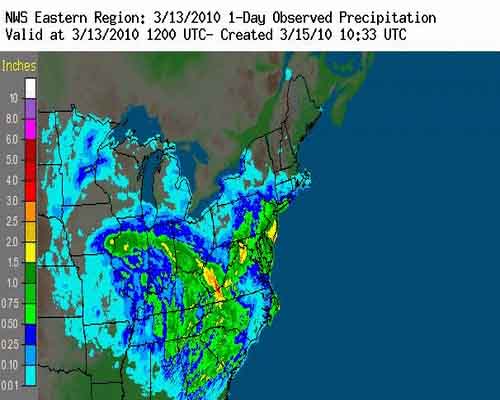Extratropical cyclones, sometimes called mid-latitude cyclones, are a group of cyclones defined as synoptic scale low pressure weather systems that occur in the middle latitudes of the Earth having neither tropical nor polar characteristics.
Following several winter storms in February 2010, a nor’easter wreaked havoc along the Atlantic seaboard in mid March. On March 13th 2010, torrential rains and strong winds killed at least 11 people and left approximately 500,000 others without electricity in Pennsylvania, New Jersey, New York, and Connecticut. New Jersey’s largest utility company stated that the storm was the worst in its history, with 420,000 power outages to customers. This major storm pounded the region for three days. Rainfall amounts of six to ten inches (150-240 mm) were reported in Massachussetts, Maine, New Hampshire, and New Jersey, while wind gusts topped more than 70 mph (113 km/hr) in many locations. States of emergencies were declared in Massachussetts, Rhode Island, and Connecticut.

Just two weeks later, another nor’easter dumped up to several more inches of rain to an already water-logged region in the northeastern U.S. The latest storm helped secure new March monthly precipitation records in many areas including LaGuardia Airport in New York City (9.55 inches [243 mm], breaking the old record of 8.73 inches [222 mm] set in 1953); Boston, Massachussetts (14.87 inches [378 mm], breaking the previous record of 11.00 inches [279 mm] set in 1953); and Portland, Maine (11.06 inches [281 mm], breaking the previous record of 9.97 inches [253 mm] also set in 1953). Boston not only recorded its wettest March but also its all-time second wettest month—the wettest was August 1955 with 17.09 inches [434 mm] of rainfall—while Providence, Rhode Island set an all-time monthly record of 16.34 inches [415 mm], breaking the previous record of 15.38 inches [391 mm] set in October 2005.
Rivers overflowed their banks to record levels, leading to severe flooding. Several media outlets reported that this was the worst flooding in 200 years in Rhode Island, where the Pawtuxet River crested at nearly 21 feet [6.4 m] (12 feet [3.7 m] above its normal level). Many areas of the state remained underwater days after the rains ended, prompting officials to declare a state of emergency as schools and roads were closed and hundreds of people were evacuated.
